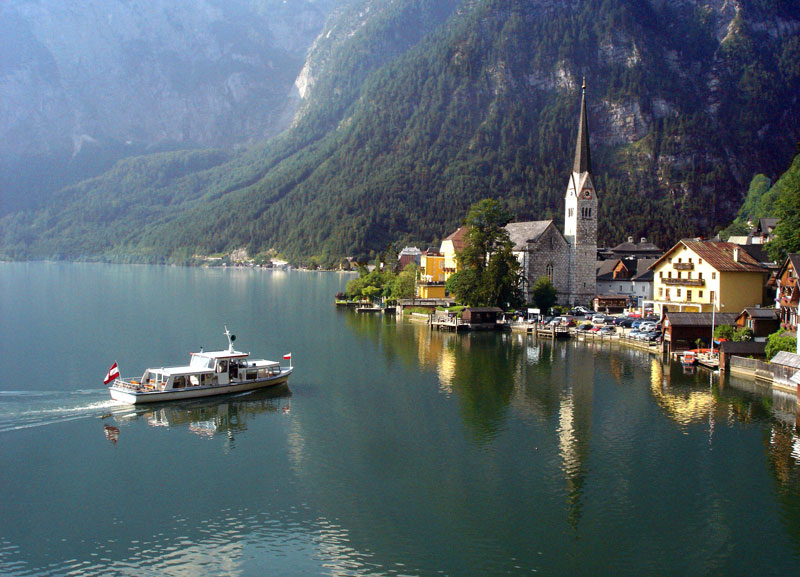Romantic Europe — places in the heart
I love it when I convince people to engage with the Europe I show them. But when they become engaged with each other in Europe, I like it even more.
Recently I heard from someone who took his girlfriend on one of my recommended hikes near Mürren, Switzerland: “I convinced Emily to get one last photo of the view with us together before it got dark, even though we were both tired and hungry and she very much wanted to relax and have a nice meal. I set up my tripod, and when she thought we were just going to pose for a photo, I got on one knee and proposed. She said ‘Yes!’”
Love is in bloom all over Europe. Couples embrace while walking the banks of the Seine River in Paris or meet along the Via dell’Amore (“Pathway of Love”) in Italy’s Cinque Terre.
At romantic spots in St. Petersburg, Russia, you’ll see newlyweds with their photographers. After the wedding ceremony, the bride and groom are practically obligated to drop by a dozen or so picturesque locations for wedding pictures. They’ll occasionally make a traditional toast with champagne, then break their glasses to proclaim their love. Watch your step!
When people ask me for romantic destinations in Europe, I steer them away from traditional spots like Venice, Paris or the Greek Islands. For true romance, I like to suggest stay-a-while getaways that are slightly off the radar, such as Hallstatt, Varenna, Gimmelwald, Ærø and Beilstein.
For a cozy hideaway, look for the offbeat areas, where creaky locals walk gingerly on creaky floorboards and where each balcony sports a flower box. The tiny town of Hallstatt, positioned picture-perfectly on the shore of Lake Hallstatt in Austria, is just such a place. It’s a gentle land, idyllic and majestic, where lakes and mountains are shuffled sloppily together — the perfect place to commune with nature (and one another), Austrian style.
On Italy’s Lake Como, Varenna whispers “luna di miele” (“honeymoon”). This village oozes romance. On the less-visited side of the lake and easily accessible by train, Varenna has a romantic promenade, a tiny harbor and narrow lanes. You’ll pass wisteria-drenched villas, evocative vistas and lakeside lovers embracing the moment. It’s just the right place to savor a cappuccino or aperitivo. There’s wonderfully little to do there, and it’s very quiet at night. It’s places like this where I really feel the romance of Europe.
Or take Switzerland’s tiny mountain hamlet of Gimmelwald. This traffic-free village hangs nonchalantly on the edge of a cliff high above the Lauterbrunnen Valley in the Swiss Alps.
At the dawn of Switzerland’s age of big-time tourism, the farmers inhabiting this tumble of rough-hewn log farmhouses voted “no” to development. While other cliff-hanging villages became soulless resorts, Gimmelwald survives as a traditional Swiss mountain community. Its two 700-year-old streets, a zig and a zag, are decorated by drying laundry, hand-me-down tricycles and hollowed stumps bursting proudly with geraniums.
Denmark’s sleepy isle of Ærø is the perfect time-passed world in which to wind down, enjoy the seagulls and cherish the one you’re with. It’s a place where sailors — out of work after the rise of steam-driven boats — decided that building ships in bottles was more their style.
Ærøskøbing is the island’s village in a bottle. It’s small enough to be cute but just big enough to feel real. The government, recognizing the value of this amazingly preserved little 18th-century town, prohibits modern building anywhere in the center. It’s the only town in Denmark protected in this way.
In Germany, cozy Beilstein is Cinderella-land — touristy but tranquil, except for its territorial swans swimming on the Mosel River. This “Sleeping Beauty of the Mosel” was accessible only by boat until about 1900, and it still seems lost in time. It’s what some visitors hope a Rhine River hamlet might be: a peaceful, romantic village slipped between impossibly steep vineyards and the river. Above the town are castle ruins with a postcard panorama; there are even better views at the top of the lone surviving tower.
Wherever couples go, they usually fall under romantic Europe’s magic spell. And for singles, there’s no denying that the romance of travel can sometimes spark a travel romance. But there are always a few outliers.
I discovered this recently at a fabulous restaurant in Florence that was serving hearty farmers’ food: grilled meats, high-quality seasonal vegetables, fresh herbs, prized olive oil and rustic Tuscan bread.
As I was savoring my meal, I heard a newlywed woman give the cuisine the wildest compliment. She told her husband, “Marrying you was fine, but this dinner makes the entire honeymoon.”
Rick Steves writes European travel guidebooks and hosts travel shows on public television and public radio. Reach him at Rick Steves’ Europe, Inc., 130 Fourth Ave. N., Edmonds, WA 98020-3114; phone 425/771-8303, www.ricksteves.com.

